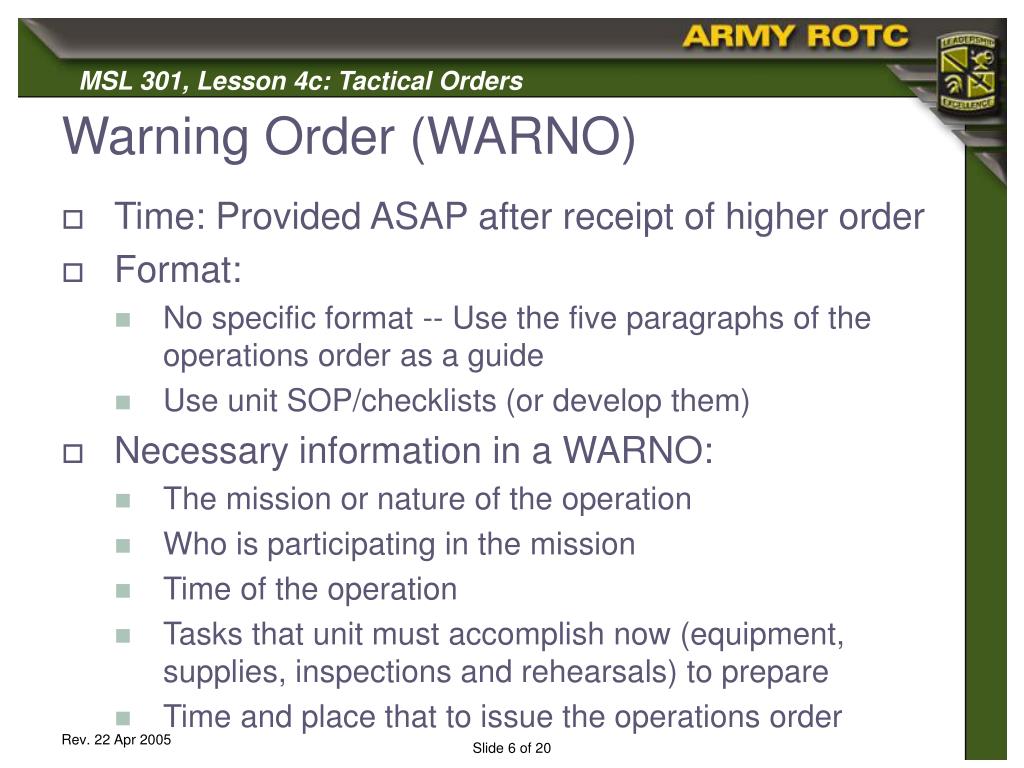
2011) when conducting Operation Clean Sweep, which is a yearly event to clean up trash and move pine cones further away from the roads at Fort Bragg. The Army develops a twenty one page OPORD with annexes (4th BCT, 82nd ABN DIV, "OPORD 11-19 4th BCT OPERATION CLEAN SWEEP," 29 Mar. Unless otherwise cited the data and analysis presented in this article is derived from these two surveys. Additionally, from my observations as an Observer Controller Trainer (OC/T) at the Joint Readiness Training Center (JRTC) a survey conducted of 61 graduates from the Maneuver Captains Career Course (MCCC) and a comparative survey of CONOPs submitted by combat arms units during JRTC rotations. The criticisms in this essay are based on my experience as a Special Forces Non-Commissioned Officer and Infantry Officer during tours in support of Operations Iraqi Freedom and Enduring Freedom. What follows is a critical look at the CONOP process. As a result, we have reduced well thought out orders to a process that goes against the tenets of counter insurgency doctrine, which emphasizes the importance of mission command. And, because approval is the ultimate goal, planning and mission analysis receives minimal attention as a leaders time is spent developing the CONOP product. These requirements are necessary for CONOP approval thus, CONOPs are often written in a way that will secure higher headquarters (HQs) approval, even if the information is not completely accurate. Therefore, commanders have added additional requirements when submitting CONOPs and these requirements differ depending on what level of CONOP submitted. Providing only the concept of the operation paragraph does not provide sufficient information to a conduct a mission. Though it was originally developed to streamline and expedite the orders process, it has done the opposite, forcing leaders to expend time, effort and energy to push the CONOP through the approval process from the lowest to the highest levels time that should be spent on mission planning. The CONOP has replaced the traditional five paragraph OPORD however, unlike the OPORD, the CONOP does not have a standardized format, nor agreed upon content and varies from unit to unit. Welton ChangĪnyone who has deployed has encountered the CONOP, which is the concept of the operation portion of a operations order (OPORD). Thomas Doherty - With contributions from Mr. The most notable difference between regular and military time format is the manner in which hours are expressed.Failing to Plan is Planning to Fail: When CONOPs Replace OPORDs To convert regular time format to the military time format use the chart below: Midnight = Military time format in fact is written with four digits, two for the hours and two for the minutes. It works on a 24- hour clock that starts at midnight which is referred to as 0000 hours, which means that 1:00 a.m. Military time format makes reading and writing of time lot easier and more compatible for communication which is desirable for military use.
#WARNO FORMAT ARMY CODE#
Military Time Code Letter Reference (Time and Date Time Group) (Photo: XY) Military time format

When referring to your time zone be sure to see what your local code identifier is by using the reference below. In fact “L” is used to represent the time code for UTC+11 which covers parts of Russia and Australia.

One common mistake when using the military time code is to use “L” as Local time. In operations spanning multiple time zones, Zulu will be used to give all operating units a time zone to adjust their time to so that everyone is on the same page. In military time code reference, Greenwich Mean time is referred to as Zulu (Z). The military time zone is used as a representation to Coordinate Universal Time (UTC) which is based on hours + or – Greenwich Mean Time (GMT) which is considered hour 0. Z- Military identifier- see below for a complete list HHMM- Time in 24 hr format +military time zone (e.g.


 0 kommentar(er)
0 kommentar(er)
